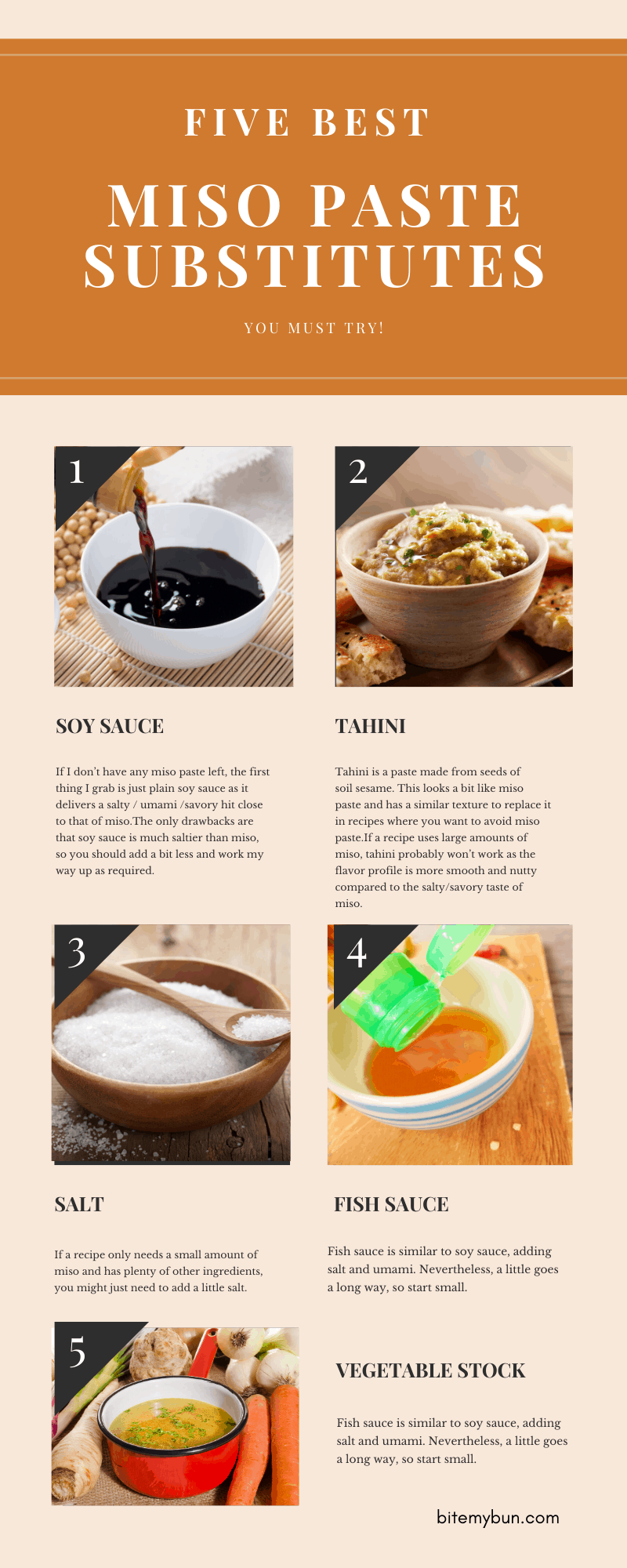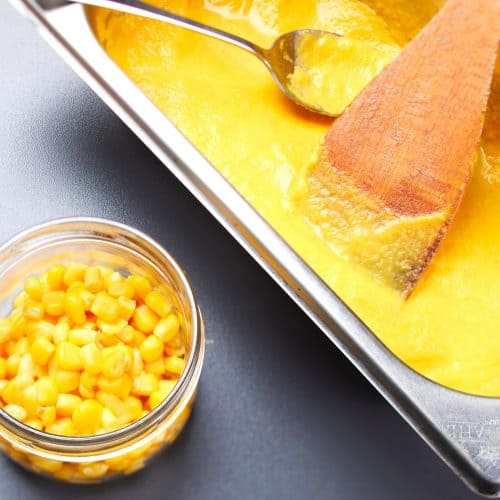5 Easy To Use Miso Substitutes So You Can Cook Your Dish!
An important part of my kitchen is the spicy, umami flavor of miso paste.
Miso paste is mainly used for soups, but you can add it to salad dressings, soups, stir-fries, or even a marinade for your meat.
A lot of our readers asked for a good miso substitute for a gluten-free or soy-free diet.
So, let’s look at some of my favorite brands of miso paste before diving into the top five alternatives to miso paste that you probably have in your kitchen right now!

When you’re looking for a specific type of miso to use in a recipe, take care to use the right alternatives.
Miso is typically produced through the fermentation of soybeans with grains and salt. There are numerous variants with different levels of strength, color, and flavor.
Alternating one type of miso with another doesn’t always taste the same, so even just swapping out white for red miso can ruin your dish!
Check out my video to see how I use these various miso substitutes.

Check out our new cookbook
Bitemybun's family recipes with complete meal planner and recipe guide.
Try it out for free with Kindle Unlimited:
Read for freeIn this post we'll cover:
Best Substitutes for Miso Paste

Soy Sauce
If I don’t have any miso paste left, the first thing I grab is just plain soy sauce as it delivers a salty / umami /savory hit close to that of miso.
The only drawbacks are that soy sauce is much saltier than miso, so you should add a bit less and work my way up as required.
Miso also has a more creamy structure than the soy liquid, so you might want to add something else with that creamy texture, depending on the dish you’re making.
Tahini
Tahini is a paste made from seeds of soil sesame. This looks a bit like white miso paste and has a similar texture to replace it in recipes where you want to avoid miso paste.
If a recipe uses large amounts of miso, tahini probably won’t work as the flavor profile is more smooth and nutty compared to the salty/savory taste of miso.
Salt
If a recipe only needs a small amount of miso and has plenty of other ingredients, you might just need to add a little salt.
Fish Sauce
Fish sauce is similar to soy sauce, adding salt and umami. Nevertheless, a little goes a long way, so start small.
Vegetable Stock
For soups, instead of miso, a full-flavored vegetable stock will work.
What does miso paste taste like?
Most people agree that it tastes like umami – one of the five tastes or flavors in Japan, considered to be a “savor” taste.
When you first taste it, it’s going to seem salty, combined with a hint of tanginess, sweetness, and earthiness.
Depending on the intensity of the paste, it will taste either slightly sweet or very meaty and salty.
The texture is similar to peanut butter, some miso is very pasty and smooth, while some are chunky.
When cooking with miso, you only need a small amount because it’s such a savory and flavored food, a little goes a long way.
How is miso made?
The ingredients are left to ferment naturally for varying lengths of time. The longer the mixture ferments, the stronger the flavor of the paste and the darker to color.
The manufacturing process is quite simple:
First, the fungus (koji) must be made. You have to add some spores to a small portion of your grain and soybeans.
You can use steamed rice, mix it with the soy, and let the culture develop. The fungus will start to form, and the starch in the mixture will turn into sugar and glutamate.
This is what gives it that specific umami flavor.
The ingredients (grains, soybeans, salt, fungus, and any additional unique ingredients) are mixed and left to ferment for a period of a few weeks for light miso and a couple of years for very dark miso.
Also read: different types of Japanese soups


Easy to find miso paste substitutes
Ingredients
- 3 cobs Corn
- 1 bunch radishes
- 3 tbsp tahini (instead of white miso paste)
- ½ tsp salt (to mimic the salty miso paste flavor)
- 3 tbsp rice vinegar
- 1 bunch coriander (AKA cilantro), torn
Instructions
- Start by preheating your oven to 200°C (400°F). Then place unpeeled corn on a tray, set it to bake for between 20 to 30 minutes. Make sure the corn kernels are hot and cooked.
- While you wait for the corn to cool down, scrub the radishes and then finely slice them into small round shapes with the help of a mandoline if you have one. If you don’t, you can also use a sharp knife and your steady hand.
- Combine miso, tahini, vinegar and 3 tbsp of olive oil in a large bowl. Test for taste and season with salt. Add extra miso if necessary.
- Once the corn is cool to the touch, peel the ribbony silks and husks. Separate the kernels from the cob and toss them in the dressing. You can now discard the husks.
- Add in the radishes and serve with coriander on the top.
Nutrition
If corn season has passed but you can’t wait to try this recipe, frozen corn will work just as well. Just remember to take into account that you will need more miso to counter the corn’s sweetness.
This recipe can serve four when served as a side dish, two if served as a main dish. It takes between 30 to 40 minutes.
Variations
You can mix and match this recipe using the following variations as a guide.
- For different vinegar, you can also use sherry vinegar, champagne vinegar or white wine vinegar. Apple cider vinegar is less preferable but can work as well.
- For different veggies, you can use frozen peas or broad beans. Snow peas, sliced, can be a great and crunchy alternative to radishes.
- For corn, you can also use frozen corn. Pan fry about 2.5 cups of corn kernels with a little butter until they’re warm. You can then toss them into the dressing.
- If you’re a carnivore, add in some crunchy bacon or you can also serve it with roast or grilled chicken, or salmon.
- To make it more substantial, feel free to add in some cooked noodles so it becomes more like a full meal, or you could also add some steamed brown or basmati rice or cooked quinoa.
- If you don’t have tahini, you can use almond butter or any other butter you prefer. You can also leave it out of the dressing and just serve the salad with sesame seeds on top.
- For different herbs, you can try basil, mint or flat-leaf parsley since they also match the flavors in this salad.
Also read: learn how to make the dashi for miso soup yourself
Conclusion
Don’t hesitate to give miso paste a try because you’ll be surprised at how easy it is to cook with it.
If you’ve been hesitant to try it, keep in mind that miso paste is a healthy, active culture food, just like yogurt!
It contributes to a healthy gut, and it also tastes great, giving flavor to all kinds of foods.
Check out our new cookbook
Bitemybun's family recipes with complete meal planner and recipe guide.
Try it out for free with Kindle Unlimited:
Read for freeJoost Nusselder, the founder of Bite My Bun is a content marketer, dad and loves trying out new food with Japanese food at the heart of his passion, and together with his team he's been creating in-depth blog articles since 2016 to help loyal readers with recipes and cooking tips.

